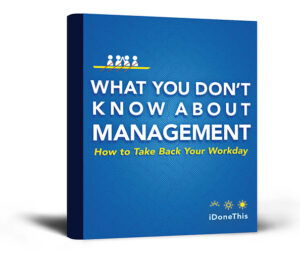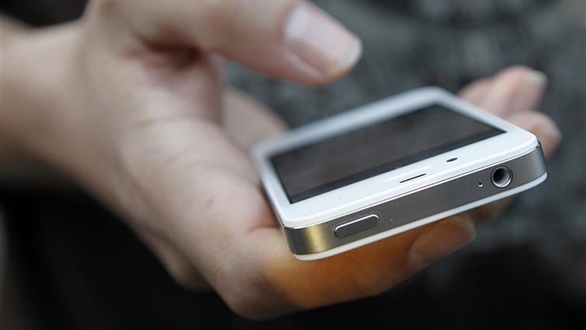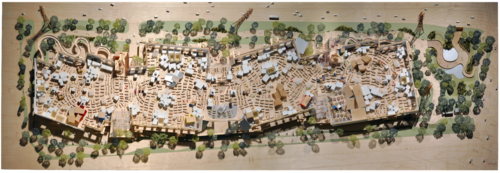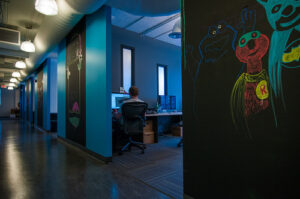Here’s an excerpt from our fresh-of-the-presses eBook, What You Don’t Know About Management: How to Take Back Your Work Day. If you like what you read, download the 50+ page eBook for free!
While teamwork is exciting and camaraderie a wonderful source of intrinsic motivation and purpose, getting stuff done also isn’t a matter of adding more people to the tasks at hand. In fact, collaboration can be too noisy.
What with all the open offices, unwelcome chit-chatters, dreadful meetings —not to mention the digital inundation of posts and pings of a never-ending stream of information — it can be near impossible to hear yourself think.
Ultimately, productivity requires producing, creativity creating — and while interaction is a key part of these processes, it isn’t everything. If you don’t actively think and process, if you don’t actually turn input and inspiration into something, if you don’t take time to reflect and analyze, then you’re shortchanging yourself.
It sounds so simple and obvious, but it’s easy to forget these days that we need solitude, quiet and time.
The Need for Solitude and Quiet Work
Everyone needs quiet time to think. Solitude is necessary to pay attention to yourself, to tune into what psychiatrist T. Byram Karasu calls your internal rhythm or music. Tuning in allows “time for previously unrelated thoughts and feelings to interact, to regroup themselves into new formations and combinations.”
Similarly, the late psychologist Ester Buchholz explains:
Solitude is required for the unconscious to process and unravel problems. Others inspire us, information feeds us, practice improves our performance, but we need quiet time to figure things out, to emerge with new discoveries, to unearth original answers…. The natural creativity in all of us—the sudden and slow insights, bursts and gentle bubbles of imagination—is found as a result of alonetime. Passion evolves in aloneness. Both creativity and curiosity are bred through contemplation.
Apple’s Steve Wozniak, too, champions alonetime for the sake of the creative process:
Most inventors and engineers I’ve met are like me — they’re shy and they live in their heads. They’re almost like artists….And artists work best alone — best outside corporate environments, best where they can control an invention’s design without a lot of other people designing it for marketing or some other committee.
We need more of what Paul Graham has identified as maker’s time (versus manager’s time). Makers need uninterrupted blocks of time to create and make progress in their work and live in their heads sometimes. This kind of schedule resists carving out units of time for discrete tasks, while managers require much more frequent interaction which can fit into scheduled slots. For a maker, a meeting can disrupt and even derail a whole day’s work.
Still, Woz’s observation isn’t just relevant to artists, inventors, and engineers — nor is it correct to say so broadly that the only and best way is to work alone. Instead, the point is how privacy, solitude, and autonomy are needed to hear what’s in your head and let your own thoughts network.
Escaping the Digital Din
Among the noisiest culprits is, of course, all our gadgets and computers. Even today’s business software, while intended to make getting work done easier, can be quite disruptive. Digital connectivity empowers collaboration but not necessarily with regard to when. Collaboration is important but not as a continuous stream that burbles at the expense being able to think and be productive.
Real-time activity feeds mirror the addictive (and time-sucking) features of Facebook and Twitter. Email never ends. When managed poorly, these feel like an endless stream of reactive work and time given to others. They demand the kind of drip-by-drip time and attention that are antithetical to the maker’s schedule and make it difficult to tune into yourself.
Merely pointing out the problem of how noisy information and work culture creates an attention wasteland is insufficient — nor does it make sense to get off the grid altogether. Instead, let’s tune into quieter channels that support the reflection and contemplation that enables us to better create.
At iDoneThis, we’re guided by something called the slow web, because we want to encourage reflection and emphasize doing, to enrich rather than detract from attention, and to help people gain insight. Slow web, as Jack Cheng has so insightfully written, is about:
Timeliness. Rhythm. Moderation. These things dovetail into what I consider the biggest difference between Slow Web and Fast Web. Fast Web is about information. Slow Web is about knowledge. Information passes through you; knowledge dissolves into you. And timeliness, rhythm, and moderation are all essential for memory and learning.
While fast web is more about unfiltered consumption and real-time updates, slow web allows some space and autonomy on how and when to engage, with timely interactions that “happen as you need them to happen.” Consider, create, and take advantage of quieter frequencies for non-urgent communication at work.
Reconsider the Open Office
The open floor plan office has become a staple of startup culture, reflecting a rejection of hierarchy and embrace of agility, collaboration and creativity. More established organizations implement open floor plans for cost savings and the supposed facilitation of interaction. As a result, many startups and organizations hoping to cultivate and project these interactive, creative characteristics miss how the setup is a main offender in the struggle for solitude and ultimate productivity.
More and more research confirms the trouble with the open plan layout, with growing evidence of reduced productivity as well as impaired attention spans, focus, motivation, and creative thinking.
According to Jungsoo Kim & Richard de Dear at the University of Sydney, the simplistic conclusion that open layouts mean easier communication, collaboration, and productivity in particular has little empirical proof. They found that people in open offices were no more satisfied with the ability to interact with coworkers than people in private offices. Overall, their findings “categorically contradict the industry-accepted wisdom that open-plan layout enhances communication between colleagues and improves occupants’ overall work environmental satisfaction.”
Noise is one of the open office’s biggest productivity killers. In fact, according to Finland’s Institute of Occupational Health, noise is “the most adverse factor” in open offices. Ambient conversations and noise contribute to “a decline of 5 percent to 10 percent on the performance of cognitive tasks requiring efficient use of short-term memory, like reading, writing and other forms of creative work.” Since the brain can understand and process intelligible speech, it’s one of the most distracting sounds. Kim and de Dear also explain, “The loss of productivity due to noise distraction … was doubled in open-place offices compared to private offices, and the tasks requiring complex verbal process were more likely to be disturbed than relatively simple or routine tasks.”
In today’s age of knowledge work, requiring both focused processing and creation of information rather than performing simple, routine tasks, these cognitive hits are damaging. One solution is to use pink noise generators, which mask the sound of speech by making it less distinguishable, reducing those cognitive breakdowns.
For all the talk about principles like openness and lack of hierarchy, open-plan offices actually reduce workers’ autonomy. You get much less control over timing and how you work. It’s the physical working equivalent of fast web. You’re always susceptible to the random notification of the shoulder tap and information deluge that promotes a work mode of interruption-driven multitasking.
According to the journal, Organization Studies, face-to-face interruptions are even more disruptive in total than email or phone calls, accounting for one-thirds more interruptions every day because they are harder to ignore.
average interruptions from communication tools a day: 9.1
average face-to-face interruptions from colleagues a day: 12.4
total average of external interruptions a day: 21.5
With research from Gloria Mark of the University of California finding that it can take an average of 23 minutes to recover from an interruption on your original task — and something like 22 interruptions a day — the maker’s schedule starts making a lot of sense.
Shopify is one startup that is reconsidering and riffing off of the standard open floor plan. In building their fourth office in their sixth year of existence, Shopify applied lessons they’d learned on what they didn’t like about open floor plans to ensure its engineers have the solitude they need to get in the zone, without regressing from the promise of the open floor plan for serendipity, collaboration, and work happiness.
Now, they work in pods, which are rooms of the six to eight people you work closely with on a daily basis. The pods make up the outside of a central hallway loop, and on the inside are small private meeting and conference rooms. Connected to the office core is a big open space called the Annex where they hold their weekly all-hands meeting and host community events. Daily free lunch and a big, central kitchen with free drinks and snacks facilitate collaboration and serendipity, but it’s when people open themselves up to it rather than a constant onslaught.
The configuration shows the value Shopify puts in quiet work, distraction-free coding, getting in a state of flow yourself while being close by your core collaborators. There’s plenty of fun to be had in the office, but those areas weren’t in places that would create distractions for others trying to work. Concentrated work happens in the work areas, hanging out in the lounge areas. This reflects an organizational value of work-life segmentation. When the iDoneThis team worked out of Shopify’s office for a week, we were shocked to see engineers come in at 9 and leave by 5 on a daily basis.
In Silicon Valley, work and play is all mixed up together so it sometimes feels like you’re expected to work and play all at the same time all the time.
Finding Joyful Flow, Even at Work
The shift from what Daniel Pink describes as the Information Age to the Conceptual Age tracks the shift in qualifications increasingly required these days. Elbowing out the historically considered “left-brain” skills of reasoning and logic that once pervaded the professional working landscape are now the supposed “right-brain” skills of creativity and synthesis.
“In a world upended by outsourcing, deluged with data, and choked with choices,” Pink writes, “the abilities that matter most are now closer in spirit to the specialties of the right hemisphere — artistry, empathy, seeing the big picture, and pursuing the transcendent.”
At Qualtrics, the research software company, CEO Ryan Smith puts it this way: “Nowadays, you’re hiring individuals to think.” That fact guides the company’s core value of extreme transparency so that its employees have all the information they need to do their jobs with focus — from visibility into the company, individual objectives, and weekly emails about what everyone got done last week and will do this week. “We can’t control the way they think,” Smith fortunately says. “All we can control or have an effect on is the environment around them.”
When the greater part of your employees’ job is to think, you should protect that brain space. Otherwise you not only jeopardize productivity and creativity, you risk the relevance and skills you’ll need to stay competitive. What’s more, in this data-deluged, thought-choking environment, we also compromise our capability to become lost and absorbed in our work. We mess with our flow, that “in the zone” state of being in which your mental energy and attention snap into focus, and you even experience joy.
Keep a work diary
Professor Amabile and Kramer recommend carving out five to ten minutes a day to keep a work diary to cultivate a practice of reflection and taking stock of your progress. Pausing to collect, coalesce, and record your thoughts about the day has a positive impact on creativity, productivity, and motivation. What’s more, keeping a record can show you patterns of noisy, disruptive productivity problems that you can avoid or address for the future. (Amabile and Kramer also provide a helpful personal work diary tool.)
Take a hike
Getting away from your desk and taking a walk is one of the best ways to think, let your mind wander, or puzzle over a problem. This is a great tactic especially for those stuck in open offices with limited options of escape to quieter work spaces.
For Colin Ross, a developer at Buffer, thinking is so integral to his job that he calls programming a “part-time job.” As part of Buffer’s distributed team, Colin works out of a number of quiet pubs during the day. He switches locations every 90 minutes and takes a 15-minute stroll to the next spot, enough to gain some perspective and think.
Try it—get out of your seat once an hour or so, take a quick stroll, do something completely different. Clean a whiteboard. Put out some rubbish. Do some laundry. Make a coffee. Anything to get away from that keyboard. The keyboard is the problem—it entices you into believing you are productive, where the reality is that the keyboard is stealing your productivity by preventing your mind from working at its full potential.
Schedule time with yourself
LinkedIn CEO Jeff Weiner schedules blocks of time with no description on his calendar, in 30 to 90 minute chunks every single day. This system of scheduling “nothing,” as he calls it, safeguards his time to think proactively and strategically. It’s a calculated system he developed “in response to a schedule that was becoming so jammed with back-to-back meetings that I had little time left to process what was going on around me or just think.”
Embrace slow web style
Just as apps running in the background of your phone drains the battery, juggling windows, tabs, app, email, and calendars all while trying to get something else done drains your attention and energy.
Ask yourself, your team, and your managers what you can do to escape the stream of interruptions from taps on the shoulder to emails. Maybe you can agree on no-meeting days or team-wide scheduled blocks of quiet time. Turn off non-urgent notifications, and find processes and tools that allow interaction as it’s needed, rather than always being dictated by others.
 This excerpt came from our fresh-of-the-presses eBook, What You Don’t Know About Management: How to Take Back Your Work Day. If you liked what you read, download the 50+ page eBook for free!
This excerpt came from our fresh-of-the-presses eBook, What You Don’t Know About Management: How to Take Back Your Work Day. If you liked what you read, download the 50+ page eBook for free!
P.S. If you liked this article, you should subscribe to our newsletter. We’ll email you a daily blog post with actionable and unconventional advice on how to work better.



